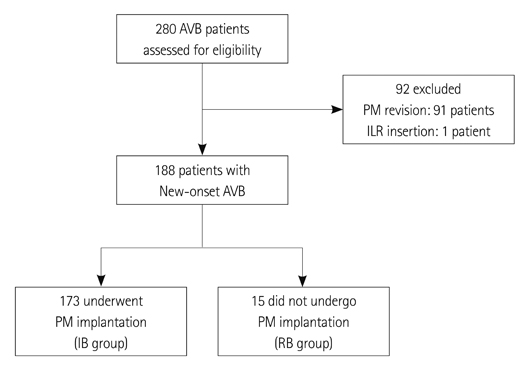Korean Circ J.
2012 Dec;42(12):816-822. 10.4070/kcj.2012.42.12.816.
Reversibility of Atrioventricular Block According to Coronary Artery Disease: Results of a Retrospective Study
- Affiliations
-
- 1Department of Internal Medicine, Seoul National University Hospital, Seoul National University College of Medicine, Seoul, Korea. seil@snu.ac.kr
- KMID: 1491097
- DOI: http://doi.org/10.4070/kcj.2012.42.12.816
Abstract
- BACKGROUND AND OBJECTIVES
The causal relationship of clinically-significant atrioventricular block (AVB) and coronary artery disease (CAD) is uncertain. We investigated whether CAD is related to irreversible AVB that requires treatment with a permanent pacemaker.
SUBJECTS AND METHODS
We included 188 consecutive patients with new-onset AVB considering pacemaker, who had undergone invasive or noninvasive coronary evaluation. Patients were divided into one of 2 groups: irreversible AVB who underwent implantation of permanent pacemaker {irreversible block (IB) group, n=173} or reversible AVB {reversible block (RB) group, n=15}.
RESULTS
In IB group, significant CAD was observed in 44 patients (25.4%) and there were 2 (1.2%) patients with acute myocardial infarction (AMI). In RB group, 14 patients (93.3%) had CAD (p<0.001) and 13 patients (86.7%) presented with AMI (p<0.001). On the aspect of CAD type and reversibility of AVB, 13/15 (86.7%) patients of AMI, 0/2 (0%) of unstable angina, and 1/41 (2.4%) of stable angina had reversible AVB.
CONCLUSION
AVB in patients with AMI is usually reversible. Therefore, permanent pacemaker implantation should be delayed in cases of AMI. AVB in patients with CAD other than AMI is usually irreversible.
MeSH Terms
Figure
Reference
-
1. Mosseri M, Meir G, Lotan C, et al. Coronary pathology predicts conduction disturbances after coronary artery bypass grafting. Ann Thorac Surg. 1991. 51:248–252.2. Mosseri M, Izak T, Rosenheck S, et al. Coronary angiographic characteristics of patients with permanent artificial pacemakers. Circulation. 1997. 96:809–815.3. Tandoğan I, Yetkin E, Güray Y, et al. Distribution of coronary artery lesions in patients with permanent pacemakers. Anadolu Kardiyol Derg. 2002. 2:279–283.4. Wei S, Zhong L, Chen S, Li X. The status of coronary artery lesions in patients with conduction disturbance. J Cardiovasc Med (Hagerstown). 2011. 12:709–713.5. Omeroglu SN, Ardal H, Erdogan HB, et al. Can revascularization restore sinus rhythm in patients with acute onset atrioventricular block? J Card Surg. 2005. 20:136–141.6. Yesil M, Bayata S, Arikan E, Yilmaz R, Postaci N. Should we revascularize before implanting a pacemaker? Clin Cardiol. 2008. 31:498–501.7. Gupta MC, Singh MM, Wahal PK, Mehrotra MP, Gupta SK. Complete heart block complicating acute myocardial infarction. Angiology. 1978. 29:749–757.8. Tans AC, Lie KI, Durrer D. Clinical setting and prognostic significance of high degree atrioventricular block in acute inferior myocardial infarction: a study of 144 patients. Am Heart J. 1980. 99:4–8.9. Nicod P, Gilpin E, Dittrich H, Polikar R, Henning H, Ross J Jr. Long-term outcome in patients with inferior myocardial infarction and complete atrioventricular block. J Am Coll Cardiol. 1988. 12:589–594.10. Feigl D, Ashkenazy J, Kishon Y. Early and late atrioventricular block in acute inferior myocardial infarction. J Am Coll Cardiol. 1984. 4:35–38.11. Tjandrawidjaja MC, Fu Y, Kim DH, et al. Compromised atrial coronary anatomy is associated with atrial arrhythmias and atrioventricular block complicating acute myocardial infarction. J Electrocardiol. 2005. 38:271–278.12. Giglioli C, Margheri M, Valente S, et al. Timing, setting and incidence of cardiovascular complications in patients with acute myocardial infarction submitted to primary percutaneous coronary intervention. Can J Cardiol. 2006. 22:1047–1052.13. Van der Hauwaert LG, Stroobandt R, Verhaeghe L. Arterial blood supply of the atrioventricular node and main bundle. Br Heart J. 1972. 34:1045–1051.14. Yesil M, Arikan E, Postaci N, Bayata S, Yilmaz R. Locations of coronary artery lesions in patients with severe conduction disturbance. Int Heart J. 2008. 49:525–531.15. Iakovou I, Schmidt T, Bonizzoni E, et al. Incidence, predictors, and outcome of thrombosis after successful implantation of drug-eluting stents. JAMA. 2005. 293:2126–2130.16. Tompkins C, Cheng A, Dalal D, et al. Dual antiplatelet therapy and heparin "bridging" significantly increase the risk of bleeding complications after pacemaker or implantable cardioverter-defibrillator device implantation. J Am Coll Cardiol. 2010. 55:2376–2382.17. Cano O, Osca J, Sancho-Tello MJ, Olagüe J, Castro JE, Salvador A. Morbidity associated with three different antiplatelet regimens in patients undergoing implantation of cardiac rhythm management devices. Europace. 2011. 13:395–401.18. Dreger H, Grohmann A, Bondke H, Gast B, Baumann G, Melzer C. Is antiarrhythmia device implantation safe under dual antiplatelet therapy? Pacing Clin Electrophysiol. 2010. 33:394–399.
- Full Text Links
- Actions
-
Cited
- CITED
-
- Close
- Share
- Similar articles
-
- Mobitz type I atrioventricular block induced by atrial pacing in a patient undergoing off-pump coronary artery bypass surgery: A case report
- A case of complete atrioventricular block persisting for 5 days in a patient with variant angina
- Atrioventricular nodal re‑entrant tachycardia with a 2:1 atrioventricular block in a young man: What is the mechanism?
- Normal Variations of Coronary Arteries in Korean by Coronary Angiography
- Acute Myocardial Infarction after Radiation Therapy for Left Sided Breast Cancer




